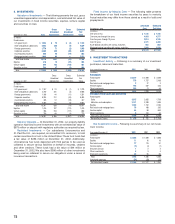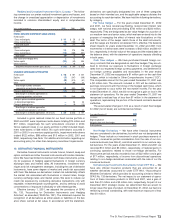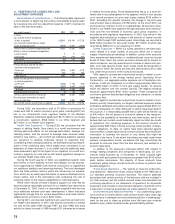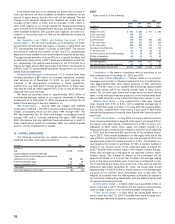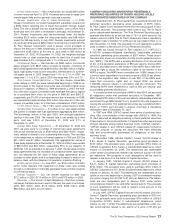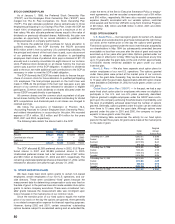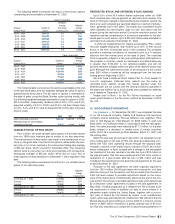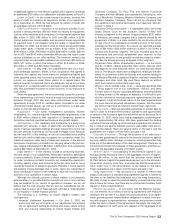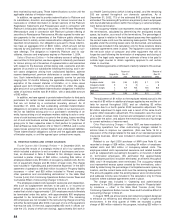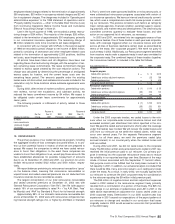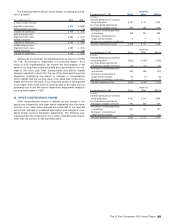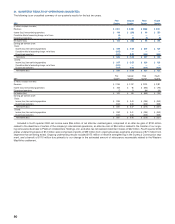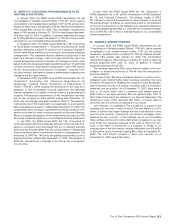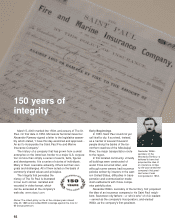Travelers 2002 Annual Report Download - page 84
Download and view the complete annual report
Please find page 84 of the 2002 Travelers annual report below. You can navigate through the pages in the report by either clicking on the pages listed below, or by using the keyword search tool below to find specific information within the annual report.
our statement of operations. The fair value of the collar agreement
was recorded as an asset on our balance sheet and adjusted quar-
terly. At the time of the sale of the Old Mutual shares, the collar had a
fair value of $12 million, which we agreed to terminate at no value in
connection with the sale. The amount was recorded as a component
of discontinued operations on our statement of operations.
In September 2001, we sold American Continental Life Insurance
Company, a small life insurance company we had acquired as part of
our MMI purchase, to CNA Financial Corporation. We received cash
proceeds of $21 million, and recorded a net after-tax loss on the sale
of $1 million.
Standard Personal Insurance Business — In June 1999, we made
a decision to sell our standard personal insurance business and, on
July 12, 1999, reached an agreement to sell this business to
Metropolitan Property and Casualty Insurance Company
(“Metropolitan”). On September 30, 1999, we completed the sale of
this business to Metropolitan.As a result, the standard personal insur-
ance operations through June 1999 have been accounted for as dis-
continued operations for all periods presented herein, and the results
of operations subsequent to that period have been included in the
gain on sale of discontinued operations.
Metropolitan purchased Economy Fire & Casualty Company and
its subsidiaries (“Economy”), as well as the rights and interests in
those non-Economy policies constituting our remaining standard per-
sonal insurance operations. Those rights and interests were trans-
ferred to Metropolitan by way of a reinsurance and facility agreement
(“Reinsurance Agreement”).
The Reinsurance Agreement relates solely to the non-Economy
standard personal insurance policies, and was entered into solely as
a means of accommodating Metropolitan through a transition period.
The Reinsurance Agreement allows Metropolitan to write non-
Economy business on our policy forms while Metropolitan obtains the
regulatory license, form and rate approvals necessary to write non-
Economy business through their own insurance subsidiaries. Any
business written on our policy forms during this transition period is
then fully ceded to Metropolitan under the Reinsurance Agreement.
We recognized no gain or loss on the inception of the Reinsurance
Agreement and will not incur any net revenues or expenses related to
the Reinsurance Agreement. All economic risk of post-sale activities
related to the Reinsurance Agreement has been transferred to
Metropolitan. We anticipate that Metropolitan will pay all claims
incurred related to this Reinsurance Agreement. In the event that
Metropolitan is unable to honor their obligations to us, we will pay
these amounts.
As part of the sale to Metropolitan, we guaranteed the adequacy
of Economy’s loss and loss expense reserves. Under that guarantee,
we agreed to pay for any deficiencies in those reserves and to share
in any redundancies that developed by September 30, 2002. We
remain liable for claims on non-Economy policies that result from
losses occurring prior to closing. By agreement, Metropolitan adjusted
those claims and shared in redundancies in related reserves that
developed. Any losses incurred by us under these agreements were
reflected in discontinued operations in the period during which they
were incurred. At December 31, 2002, our analysis indicated that we
owed Metropolitan approximately $13 million related to these agree-
ments. Subsequent to year-end 2002, we have had additional settle-
ment discussions with Metropolitan regarding final disposition of the
agreements, and have tentatively agreed to an amount that is within
established reserves. We anticipate making that payment to
Metropolitan in the first quarter of 2003. We have no other contingent
liabilities related to this sale.
Nonstandard Auto Business — In December 1999, we decided to
sell our nonstandard auto business marketed under the Victoria
Financial and Titan Auto brands. On January 4, 2000, we announced
an agreement to sell this business to The Prudential Insurance
Company of America (“Prudential”) for $200 million in cash, subject to
certain adjustments based on the balance sheet as of the closing
date. As a result, the nonstandard auto business results of operations
were accounted for as discontinued operations for the year ended
December 31, 1999. Included in “Discontinued operations — gain
82
(loss) on disposal, net of tax” in our 1999 statement of operations was
an estimated loss on the sale of approximately $83 million, which
included the estimated results of operations through the disposal
date. All prior period results of nonstandard auto have been reclassi-
fied to discontinued operations.
On May 1, 2000, we closed on the sale of our nonstandard auto
business to Prudential, receiving total cash consideration of approxi-
mately $175 million (net of a $25 million dividend paid to our property-
liability operations prior to closing).
The following table summarizes our discontinued operations,
including our life insurance business, our standard personal insurance
business, our nonstandard auto business and our insurance broker-
age business, Minet (sold in 1997), for the three-year period ended
December 31, 2002.
Years ended December 31 2002 2001 2000
(In millions)
Operating income, before income taxes $— $19 $53
Income tax benefit ——(10)
Operating income, net of taxes —19 43
Gain (loss) on disposal, before income taxes (42) (61) (25)
Income tax expense (benefit) (17) 37 (5)
Gain (loss) on disposal, net of taxes (25) (98) (20)
Gain (loss) from discontinued operations $(25) $(79) $ 23
The following table summarizes our total gain (loss) from discon-
tinued operations, for each operation sold, for the three-year period
ended December 31, 2002.
Years ended December 31 2002 2001 2000
(In millions)
Life insurance $(12) $(55) $ 43
Standard personal insurance (7) (13) (11)
Nonstandard auto insurance (3) (5) (9)
Insurance brokerage (3) (6) —
Gain (loss) from discontinued operations $(25) $(79) $ 23
17. COMMITMENTS, CONTINGENCIES AND GUARANTEES
Investment Commitments — We have long-term commitments to
fund venture capital investments totaling $920 million as of
December 31, 2002. Of that amount, approximately $620 million of
commitments are to fund investments in St. Paul Venture Capital VI,
LLC (“Fund VI”), one of our venture capital investment subsidiaries.
Additional amounts have been committed to fund new and existing
investments in partnerships and certain other venture capital
entities. Our future obligations as of December 31, 2002 are esti-
mated as follows.
New Existing
Year Fund VI Partnerships Partnerships Total
2003 $ 170 $ 20 $ 25 $ 215
2004 180 60 23 263
2005 180 50 17 247
2006 50 50 10 110
Thereafter 40 40 5 85
Total $ 620 $ 220 $ 80 $ 920
Generally, we expect that our obligations to make the capital contri-
butions listed in the table above will be largely funded by distributions
we receive from our venture capital investments. The maximum
amount of new capital we are obligated to contribute to satisfy those
obligations to Fund VI in any calendar year without receiving any off-
setting distributions from our venture capital operation is $250 million
and, on a cumulative basis over the life of Fund VI, no more than
$325 million. In addition, we can elect to discontinue funding Fund VI
at any time. If we do so, we must contribute $250 million (not reflected
in the table above) to a termination fund and pay certain termination
and management fees. Alternatively, once 70% of the Fund VI capital
has been committed, we must elect either to commit a material amount


